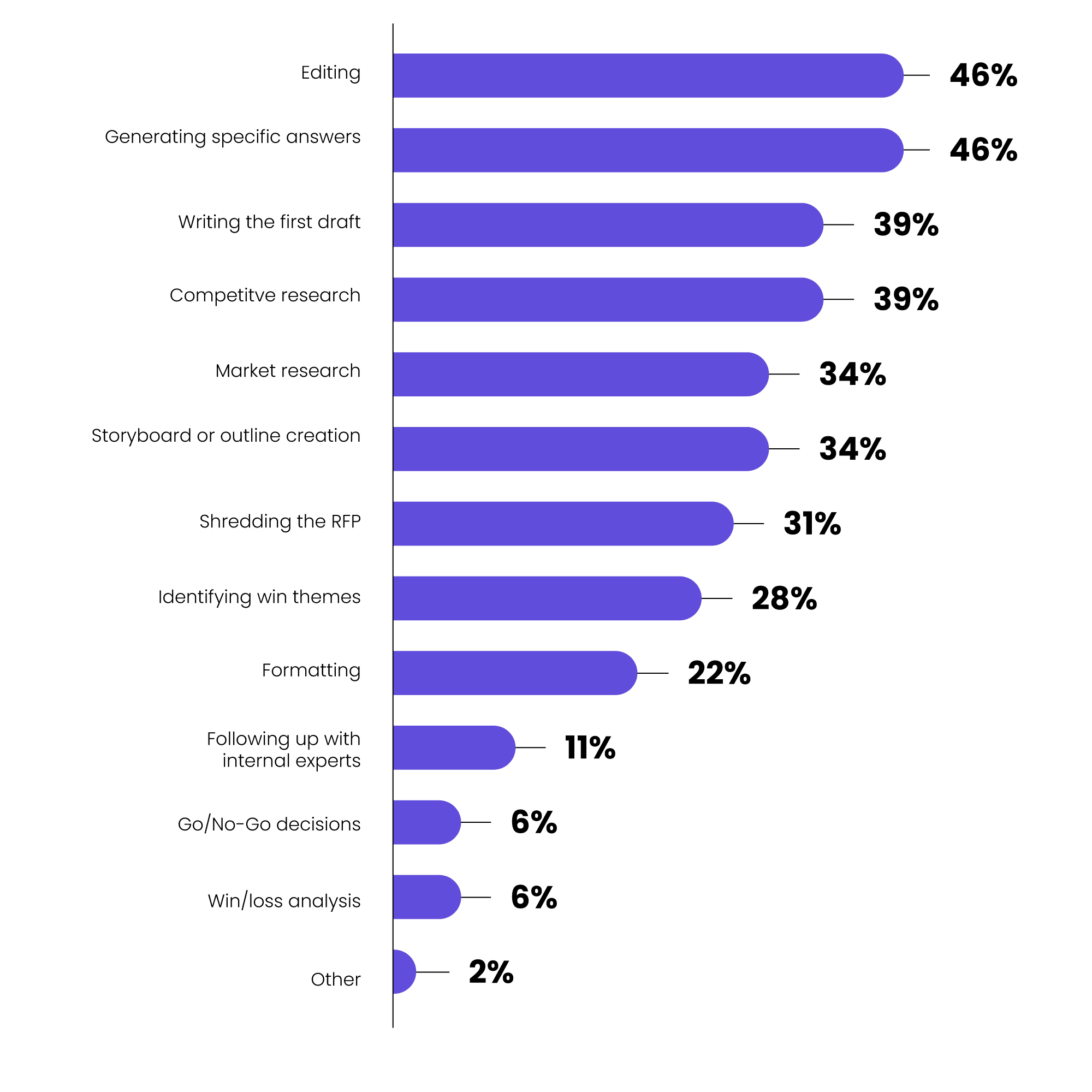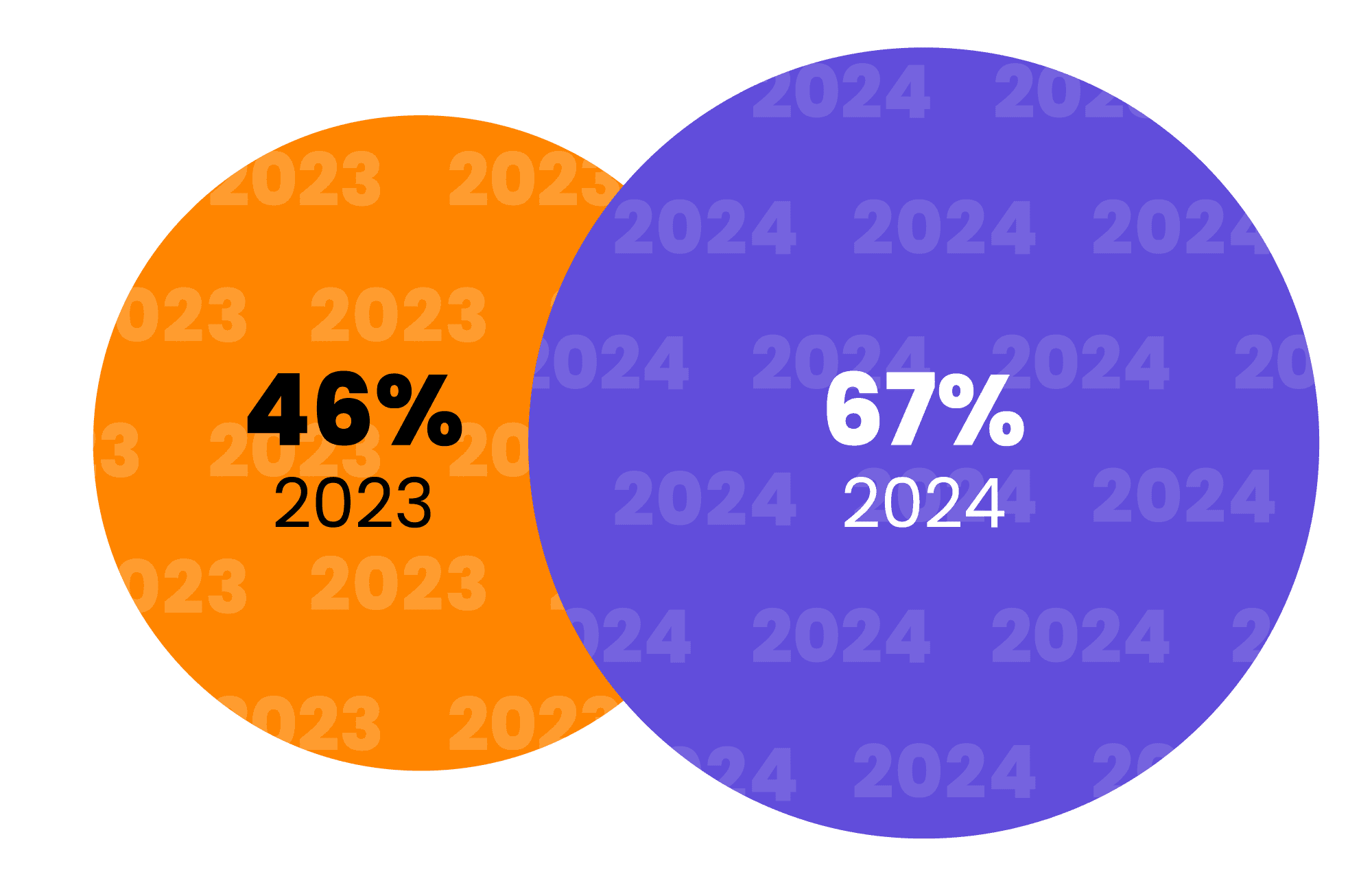New Research: How Teams Use Generative AI for RFP Responses
The RFP industry is fiercely competitive. But using AI can be like having the sharper sword in a duel—it gives you a competitive edge. 🤺
This technology can help you win more deals faster by assisting with tasks from the early stages of drafting content to performing a win theme analysis.
Of course, there are potential drawbacks (which are also worthy of pause and consideration). That’s why, in this article, we’ll be exploring new research from Loopio’s RFP Trends & Benchmarks Report to learn how teams are actually using generative AI for RFP responses and how you can, too.
How Proposal Teams Really Feel About Generative AI: Yay or Nay?
In 2023, RFP teams were just starting to explore generative AI, but only 34% had worked it into their day-to-day. Fast forward to this past year, and that curiosity has turned into real adoption. Our survey shows that 68% of teams have now used generative AI in the past twelve months—twice as many as the previous year.
Now that more teams are using generative AI for RFP responses, how do they actually feel about it? It turns out that attitudes have also shifted in a big way. This year, 67% of teams feel positively about the technology, up from just 46% the year before. What’s the verdict then? RFP teams are giving generative AI a thumbs up. 👍
Percent of Teams Who Feel Positive Toward AI (2023 vs. 2024)
The Benefits of Using Generative AI for RFP Responses
AI is quickly evolving from a neat experimental tool to a must-have for proposal teams aiming for efficiency, productivity, or a competitive edge. Let’s be clear: AI is not perfect, and it is certainly not a hands-off tool. It works best when paired with a human copilot to craft a standout RFP response that wins new business. That said, here are the key benefits AI has to offer:
-
Efficiency: Free Up Time for What Matters
While AI can handle tedious, repetitive tasks (like figuring out which SME to tag for reviews), your proposal team can free up time for high-impact tasks that require the human touch. For example, you can focus your efforts on crafting compliant, relevant, and personalized content, ultimately improving engagement with evaluators and enticing busy decision-makers.
-
Convenience: Access Content at Your Fingertips
AI can help you beat the blank page with trusted, curated information at the start of the proposal generation process. For example, Loopio’s RFP response software centralizes all your responses so that your team can quickly find vetted answers. But if you can’t seem to find exactly what you’re looking for, you can use AI to generate answers based on knowledge in your trusted library. Basically, it’s a speedy sidekick for any proposal manager.
-
Editing: Support From a Virtual Companion
AI acts as your brainstorming partner to help you spark fresh ideas. Like any helpful writing buddy, it can tailor the tone and formality of your writing for an RFP. Plus, AI functions as a neutral proofreader, providing that crucial second set of eyes to catch errors when the words seem to blur together. 😵💫
🤖 RFP Software Users More Likely to Try AI
It’s no coincidence that 77% of software users have tried generative AI, compared to just 50% of non-software users. Many RFP response tools, like Loopio, have built generative AI features into their platform to help improve efficiency. 🤖 That means it’s not only easy for them to access, but it’s also a trusted space to experiment.
Loopio’s AI RFP software, for example, helps you securely generate answers, connect with the right SME, and improve answers based on writing best practices—all powered by AI technology.
5 Ways Proposal Professionals Are Adopting AI in 2025
Artificial intelligence has been in the industry for a few years now, and with adoption on the rise, teams using generative AI for RFP responses have moved beyond being early adopters to avid users. In fact, 70% of them use AI at least once a week.
So, how are these teams putting AI to work? Nearly half of them use it to generate specific RFP answers and edit their responses. Other top use cases include writing the first draft, competitive research, market research, and storyboarding.

How Teams Use AI in the Response Process
Here are five tactical examples of how RFP teams are leveraging AI to streamline their workflow and give themselves a competitive advantage. 💪
1. Editing the RFP Response
46% of teams say they’re using AI to refine the RFP response in the editing stage. You can use AI to predict potential pitfalls, highlight areas that need extra attention, and suggest ways to frame value propositions more effectively. If you provide specific instructions, it can also edit content for clarity and coherence with the RFP guidelines. AI can even check for grammar or spelling errors, suggest better word choices, and ensure that responses have the same tone throughout because consistency is key.
2. Generating Specific Answers
RFPs often come with hundreds of questions, so it’s no surprise that teams are turning to generative AI to save time answering them. But here’s the catch: only 33% of teams generate answers from their trusted content library, while 65% rely on tools like ChatGPT. That’s not just a riskier approach—it can also be less efficient. After all, are you really saving time if you have to fact-check everything, instead of pulling from content that’s already been reviewed by your team and SMEs?
3. Write a Faster First Draft
With the help of AI, first-draft RFP responses can be created lightning-fast. ⚡ That’s because AI can assist in generating responses that align with the RFP criteria by quickly processing and interpreting the requirements of an RFP. This speeds up the initial drafting by providing your team with examples of how to respond (which in turn reduces blank page anxiety). With this speedy first draft, you can now focus on refining and customizing the content to the buyer’s needs.
4. Competitive Research & Market Analysis
When we first asked 1,500+ RFP teams how they wanted to use AI, competitive research topped the list. But today, only 39% are actually using it for that purpose—despite the clear advantages. Generative AI can quickly analyze massive amounts of data to uncover market trends, evaluate competitors, and understand buyer personas. By tapping into AI for these insights, proposal teams can sharpen their positioning and tailor responses to what decision-makers really care about: gaining a serious edge over teams that don’t.
5. Storyboard or Outline Creation
Super tight turnaround times are a struggle proposal managers know all too well. In the rush to meet these deadlines, the strategic step of outlining or storyboarding often gets sacrificed. But AI can be a valuable asset to offset this during crunch time. ⏱️ While this technology won’t replace your expertise, it can act as a powerful brainstorming buddy, saving you valuable hours to quickly put together an outline for your proposal.
💡 AI Advancements for SME Collaboration
According to the 2025 RFP Trends Report, the top challenge for proposal teams is collaboration with internal subject matter experts (SMEs). As companies expand, tracking down the right person to answer or verify responses for a proposal becomes increasingly challenging.
That’s where AI-powered features like Recommended Experts come in. This helpful Loopio-specific tool can identify and connect you with the right SME in your organization to quickly review the accuracy of a response. That means your RFP will use the experience of your in-house experts, but without all the back-and-forth. Phew. 😎
Related: New: Need Sales Answers Fast? Access Loopio From Anywhere
How to Balance AI-Generated Content with Human Expertise
Although AI-generated proposals are on the rise, the importance of human expertise cannot be overstated. AI-generated content can boost productivity (and speed), but only when paired with a human who knows how to effectively coach it. Your expertise as a proposal professional is what crafts a winning proposal to align with your company’s unique voice and value props.
That’s why we recommend keeping these four considerations in mind (below) when using AI for your proposal program.
-
Personalize Your Proposal With the Human Touch ⭐
As procurement teams see more and more AI-generated content, submitting personalized, original responses will help you stand apart from the competition.
Your unique creativity and detailed knowledge are vital for editing AI-generated outputs and ensuring that proposals are meticulously tailored to the client’s requirements. In this context, human-written cover letters play a crucial role in connecting to the buyer personally, and showcasing attention to detail for their specific needs.
-
Always Factcheck to Maintain Proposal Integrity
Over 75% of consumers are concerned about misinformation from AI. 🤯 And it’s a valid concern, especially when it comes to proposal management. Human oversight is necessary to ensure the content you create is accurate.
To maintain integrity and authenticity, AI-generated content should always be fact-checked by proposal managers, writers, or other team members. AI-generated content may serve as an initial draft, but avoid direct copying and pasting when creating proposals. Using your expertise vs. AI means you’ll also avoid risks like copyright infringement or using someone’s intellectual property.
-
Train and Develop an AI-Ready Team
Having an AI-ready team is as crucial as choosing the right AI tool. Understanding the capabilities and limitations of different AI models is paramount, and teams should be trained on how to interact with these tools.
The ability to vet AI-created content and knowing when to add the human touch are essential for maintaining proposal quality. That’s why training should encompass:
- Education about industry-specific legal regulations
- An understanding of how data is collected and analyzed
- Ethical considerations like bias and responsible AI usage
Once you’ve selected an AI tool that is safe, meets your standards, and you’ve trained your team–you’ll be ready to create high-quality proposals with less effort.
-
Follow Company-Wide Policies and Safeguards
Implementing comprehensive security policies is a key step in mitigating risks with AI-driven proposal development. That’s why most organizations:
- Implement data privacy and compliance protocols for AI
- Outline how employees can adhere to privacy policies when using AI tools
- Establish an accountability structure to address any violations
Open AI technology like ChatGPT carries inherent risk, but selecting the right AI-driven response software means there are assurances around data protection and compliance. For example, Loopio takes integrity, ethical conduct, and compliance seriously in all aspects of its business—especially for the AI functionality in our platform.
🤖 Choose the Right Artificial Intelligence Tools for Your Proposal Creation Process
While proposal writing AI offers tons of benefits, choosing the right tool is crucial. It’s important to compare features and ask the right questions, like:
- Does the AI solution integrate with your CRM?
- Is it compatible with existing workflow tools?
- Will it protect sensitive data from past proposals?
- Is the information it’s pulling from, accurate & up-to-date?
- Is the time saved using artificial intelligence greater than the time spent reviewing its output?
The Future of AI in Proposal Development
Looking ahead, AI has a promising future for RFP teams. It can act as your not-so-secret weapon to give you an edge in an increasingly competitive market. That is, if you continue to balance its benefits with human expertise.
According to a report from Bloomberg Intelligence, the AI market size is expected to reach $1.3 trillion by 2032. The market is exploding, and proposal teams who ignore this trend may risk falling behind. When used correctly and paired with the best-in-class RFP software, AI can revolutionize the entire proposal process.

